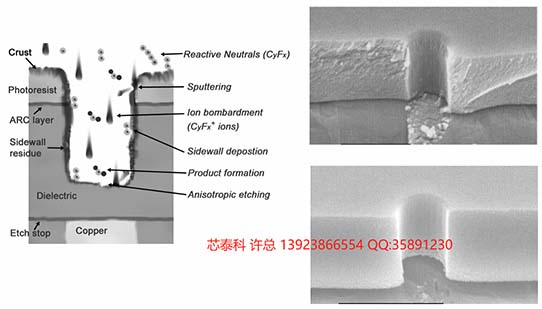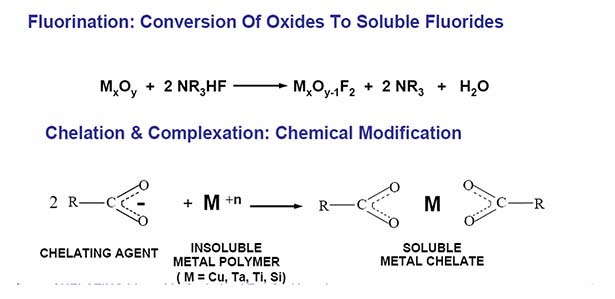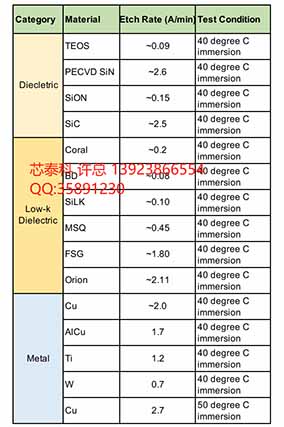新闻中心
半导体干法刻蚀后、清洗去胶液,替代ATMI ST-250英特
发布日期:2024/11/26 16:48:12
浏览次数: 点赞数: 收藏数: 关注数: 【赞一个】 【举报】 【收藏】 【关注】 半导体干法刻蚀后、清洗去胶液,替代ATMI ST-250英特格Post-Etch Residue
Removal Solution半导体干法刻蚀后清洗去胶液,替代ATMI ST-250(英特格)
深圳市芯泰科光电有限公司
产品热线许经理 :13玖23八66554 扣扣:35捌9123零
深圳市芯泰科光电有限公司,创立于2014年,是一家服务于微电子领域的产品贸易及技术服务提供商。我们已经成为国内微电子制程领域和相关大学研究所信赖的合作伙伴;公司秉持以忠诚态度对待新旧客户,以客户满意为导向,提供优质高效率的专业服务,提供产品行销及技术支援解决方案。我们目标是成为一家新材料应用技术推广服务的专业供应商。
Post-Etch Residue
Removal Solution
Origin Example of Post-Etch Residue

Fluorocarbon post-etch residue characterization
Residue type: PR residues, PR crust, post-ash residue (Carbon contained
organic polymers), plasma post-etch residue (X contained
oxides polymers), metal oxides, Si-oxides, metal complex….
Strategy for Post-Etch Residue Removal
1. Surface wetting: surfactant additive to lower down
surface tension of cleaning solution
2. Solvent Dissolution: dissolve organic residue polymers
3. Degradation: controlled wet-etching to remove inorganic
reside
4. Coordination: forms metal-lig complex compounds to
remove metal containing residue
5. Corrosion control: use corrosion inhibitor to prevent
damage to metals, dielectrics, other materials
ZS-750 Residue Remover Design Concept
1. Capable to remove all post-etch residue at RT~50oC
2. Short process time
3. Buffered solution to keep alkaline pH
4. Nodamage to dielectric materials
5. No Cu corrosion
6. Electronic grade clean solution
7. Compatible to wet bench SWT
8. Excellent bath life
9. HDA-free
Amines Alkaline pH buffer, organic residue remova
Fluoride Inorganic residue degradation
Metal chelator Metal oxide/ion removal, buffer
Surfactant Organic inorganic residue removal, surface wetting
Corrosion Metal corrosion control surface conditioning
Inhibitor
Pourbaix
in
diagram for copper
uncompld media

Copper corrosion can be controlled better in alkaline pH environment!
Surface Wetting Phenomen
a

Surface wetting is critical mechanism to bring cleaning solution to contact with
small dimension structure surface to ensure well reaction between effective
ingredients residues!
Coordination Chemistry to Dissolve
Metal-containing Residues

Recommended Process Temperature Range
1. Recommended process temperature for ZS-750 is
30~60oC.
2. Spray performance is not good enough for SWT due to
higher viscosity of cleaning solution.
3. Reactions may not be activated well enough to remove
residues at temperature lower than 30oC.
4. Higher process temperature may cause faster metal (Cu)
oxidation in ambient atmosphere (O2 presence) which
resulted in higher etch rates
Cleaning Performance Example 1

Cleaning Performance Example 2

Cleaning Performance Example 3

Quality Control Items CoA

ZS-750 Etch Rates
to Blanket Films

Tested by immersing coupons into ZS-750
at ambient lab environment followed by direct
DIW rinse CDA drying.
Process Tools Bath Life
1. ZS-750 can be used in immersion wet bench or
spray-type single wafer tools (SWT).
2. ZS-750 bath life is up to 96 hrs or longer!
3.Major failure mechanism is water content change
due to evaporation or moisture absorption/bring-in
wafer loadings.
4. Water content monitoring replenish is helpful
to bath life extension